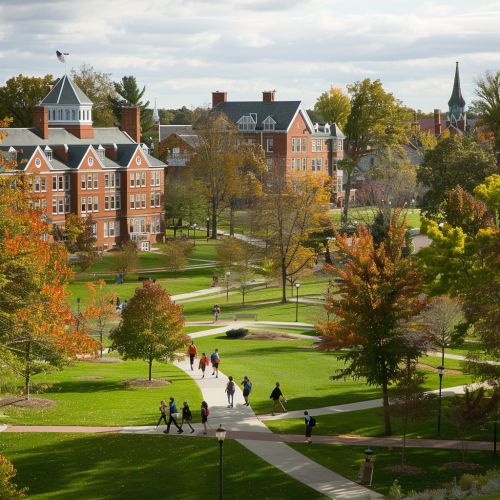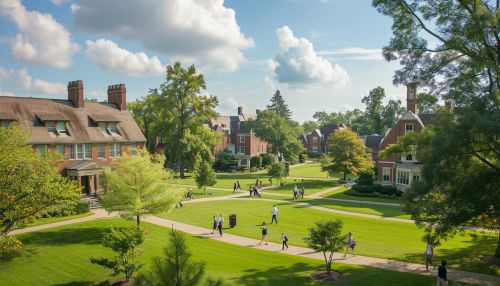Liberal arts colleges: Difference between revisions
No edit summary |
No edit summary |
||
| Line 78: | Line 78: | ||
* [[Financial Aid]] | * [[Financial Aid]] | ||
[[Image:Detail-92651.jpg|thumb|center|A picturesque view of a traditional liberal arts college campus with historic buildings, green lawns, and students walking.]] | [[Image:Detail-92651.jpg|thumb|center|A picturesque view of a traditional liberal arts college campus with historic buildings, green lawns, and students walking.|class=only_on_mobile]] | ||
[[Image:Detail-92652.jpg|thumb|center|A picturesque view of a traditional liberal arts college campus with historic buildings, green lawns, and students walking.|class=only_on_desktop]] | |||
Latest revision as of 06:58, 19 June 2024
Overview
Liberal arts colleges are institutions of higher education in the United States that emphasize undergraduate education in the liberal arts and sciences. These colleges are characterized by small class sizes, close interactions between faculty and students, and a focus on developing critical thinking, communication, and analytical skills. The curriculum is designed to provide a broad-based education that encourages intellectual curiosity and a lifelong love of learning.
History
The concept of liberal arts education dates back to ancient Greece and Rome, where it was considered essential for a free person to participate in civic life. The term "liberal arts" comes from the Latin "artes liberales," meaning "arts worthy of a free person." During the Middle Ages, the liberal arts were codified into the trivium (grammar, rhetoric, and logic) and the quadrivium (arithmetic, geometry, music, and astronomy).
In the United States, the first liberal arts college was Harvard College, founded in 1636. Other early liberal arts colleges include Yale College (1701) and Princeton University (1746). These institutions were initially established to train clergy but gradually expanded their curricula to include a broader range of subjects.
Curriculum
Liberal arts colleges typically offer a curriculum that includes courses in the humanities, social sciences, natural sciences, and mathematics. Students are often required to take courses in a variety of disciplines to ensure a well-rounded education. The goal is to develop a broad knowledge base and transferable skills that can be applied in various fields.
Humanities
Courses in the humanities include literature, philosophy, history, and the arts. These subjects encourage students to explore human culture, values, and expression. They develop skills in critical reading, writing, and interpretation.
Social Sciences
The social sciences include disciplines such as psychology, sociology, anthropology, political science, and economics. These courses help students understand human behavior, social structures, and institutions. They emphasize research methods, data analysis, and theoretical frameworks.
Natural Sciences
Natural science courses cover subjects like biology, chemistry, physics, and environmental science. These disciplines focus on understanding the natural world through observation, experimentation, and scientific reasoning. Students develop skills in laboratory techniques, data collection, and analysis.
Mathematics
Mathematics courses are designed to develop quantitative reasoning and problem-solving skills. Topics may include calculus, statistics, algebra, and discrete mathematics. These courses are essential for students pursuing careers in science, technology, engineering, and mathematics (STEM) fields.
Pedagogical Approach
Liberal arts colleges are known for their distinctive pedagogical approach, which emphasizes active learning, critical thinking, and close student-faculty interactions.
Small Class Sizes
One of the hallmarks of liberal arts colleges is their small class sizes, which typically range from 10 to 20 students. This allows for more personalized instruction and meaningful interactions between students and professors. Small classes also facilitate active learning techniques such as discussions, debates, and group projects.
Faculty Engagement
Faculty at liberal arts colleges are often deeply committed to teaching and mentoring. They are accessible to students outside of class and often involve students in their research projects. This close relationship fosters a supportive learning environment and encourages intellectual exploration.
Interdisciplinary Learning
Liberal arts colleges often promote interdisciplinary learning, encouraging students to make connections between different fields of study. This approach helps students develop a more integrated understanding of complex issues and prepares them for the interconnected world.
Admissions
Admissions to liberal arts colleges are typically competitive, with a holistic review process that considers academic achievements, extracurricular involvement, personal essays, and letters of recommendation. Many liberal arts colleges are also test-optional, meaning they do not require standardized test scores for admission.
Financial Aid
Liberal arts colleges often provide generous financial aid packages to ensure that education is accessible to students from diverse socioeconomic backgrounds. Financial aid may include scholarships, grants, work-study opportunities, and loans. Many colleges use a need-blind admissions process, meaning they do not consider an applicant's financial situation when making admissions decisions.
Notable Liberal Arts Colleges
Some of the most well-known liberal arts colleges in the United States include:
These institutions are renowned for their rigorous academics, vibrant campus communities, and strong alumni networks.
Challenges and Criticisms
While liberal arts colleges offer many benefits, they also face several challenges and criticisms.
Cost
The cost of attending a liberal arts college can be high, with tuition and fees often exceeding $50,000 per year. While financial aid can offset some of these costs, the high price tag can be a barrier for many students.
Relevance
Some critics argue that a liberal arts education is less relevant in today's job market, which increasingly demands specialized skills and technical expertise. However, proponents of liberal arts education argue that the critical thinking, communication, and problem-solving skills developed through a liberal arts curriculum are valuable in any career.
Diversity
Liberal arts colleges have historically struggled with issues of diversity and inclusion. Many colleges have made efforts to increase the representation of underrepresented groups among students, faculty, and staff, but challenges remain.
Future of Liberal Arts Colleges
The future of liberal arts colleges will likely involve adapting to changing educational landscapes and societal needs. This may include:
- Integrating technology into the curriculum to enhance learning and prepare students for a digital world.
- Expanding interdisciplinary programs to address complex global challenges.
- Strengthening partnerships with other institutions and organizations to provide students with diverse learning opportunities.
- Continuing efforts to increase diversity and inclusion on campus.
See Also
- Higher Education in the United States
- Liberal Arts Education
- Interdisciplinary Studies
- Undergraduate Education
- Financial Aid


